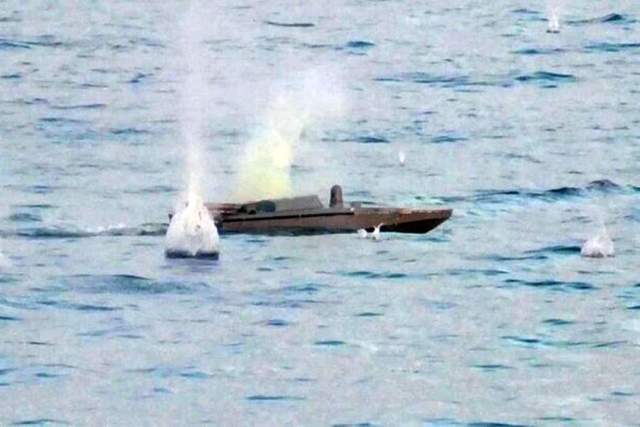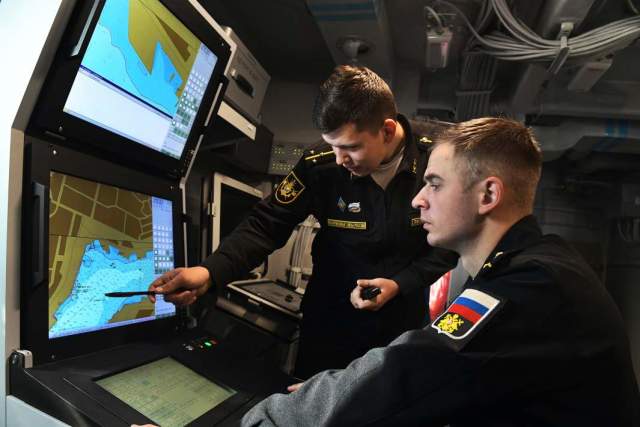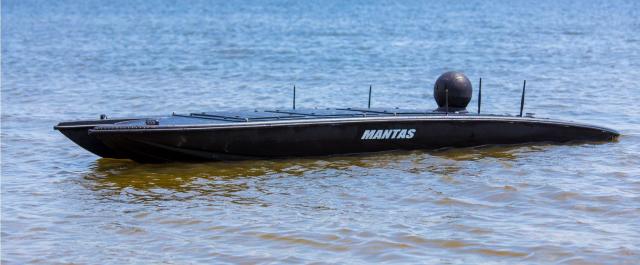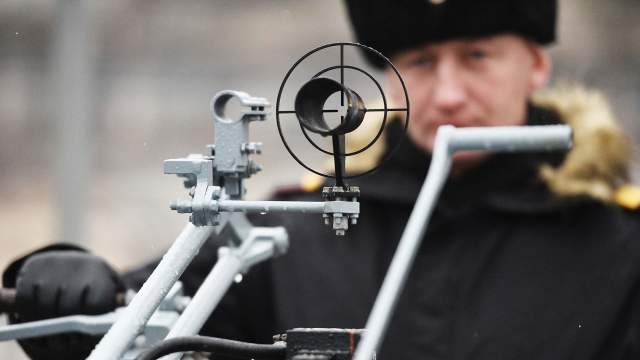The new course has been included in the combat training program of all Russian fleets
Ships of the Russian Navy will begin to regularly practice the fight against naval drones. The new training course will be included in the Naval surface forces combat training program, a source in the Russian Defense Ministry told Izvestia. During training and combat exercises, crews will have to detect approaching unmanned boats and destroy them. The events of this year have shown that surface drones are becoming one of the most important threats to the modern fleet. At the same time, they represent a difficult goal, experts say.
Fire on drones
The combat training program for surface ships of the Russian Navy will include a new training course — repelling the attack of unmanned boats. As a source told Izvestia in the Ministry of Defense of the Russian Federation, the development of relevant documents has been completed, new combat exercises have been tested on all fleets.
— Before the special military operation, the Navy ships, when completing course tasks, performed combat exercises to destroy a small-sized high-speed target or a floating mine. But on the basis of real combat experience, the instructions and methods are now being supplemented," the source told the publication.
According to him, the Russian Navy gained its first combat experience in destroying high-speed boats in the 2000s, when our warships as part of the international coalition took part in the fight against Somali pirates in the Indian Ocean.
— The fight against marine drones is significantly different from the fight against pirate or sabotage boats, — explained the source of Izvestia. — The task of the drone is to approach our ship from a favorable heading angle in order to reduce the firing sector for the crew and get to the distance of detonating the warhead. We teach the crew how to maneuver competently when attacking a drone in order to ensure that it is destroyed by artillery fire or heavy machine guns at a safe distance, interfere with electronic warfare, conduct visual and radio reconnaissance.

Destruction of an unmanned AFU boat in the Black Sea
Image source: Photo: Ministry of Defense of the Russian Federation
Izvestia got acquainted with the report on the results of the Arctic expedition group of the Northern Fleet, which ended in October. The large anti-submarine ship Vice Admiral Kulakov and the large amphibious assault ship Alexander Otrakovsky took part in it. The document notes that, among other combat exercises, the crews conducted training on detecting and tracking a small—sized target simulating a combat drone, and subsequently destroying it using naval artillery and small arms.
For the VFU, the successful actions of Russian warships in the Black Sea are the subject of increased attention. The naval blockade of the coast, launches of Calibres, the constant threat of amphibious landings — all this forces the enemy to come up with increasingly complex tactics to counter the Russian Navy, military expert Dmitry Boltenkov told Izvestia.
"For these reasons, they will actively fight our ships," he said. — In particular, they relied on unmanned boats. And they have already become a danger and a headache for us.

Photo: RIA Novosti/Vitaly Ankov
Image source: iz.ru
Marine drones are small boats with sides that do not protrude much above sea level.
— The most important thing is to detect such a target in a timely manner, — Dmitry Boltenkov explained. — Therefore, it is necessary to competently organize round-the-clock monitoring of the sea surface. The algorithm of actions is simple: observation, detection, destruction. Also, the crew must be ready to maneuver in order to get away from the impact. Of course, cannons and machine guns will be used to destroy such drones.
According to the expert, to destroy such boats, AK-630 rapid-fire automatic guns should be used, which were previously oriented to combat cruise missiles. In addition, the ships can be reinforced with heavy machine guns. And in the bays and bases, it is necessary to organize coast guards, put up protective booms.
— It is important for Navy ships to work together with aviation, which has already proven its effectiveness in detecting and destroying marine drones. Our fighters, using radar, as it turned out, can see such boats well. They are already using Mi-8 and Ka-29 helicopters in the fight against them, which have also proven their effectiveness," Dmitry Boltenkov summed up.
Ka-29 helicopter
Image source: Photo: TASS/Vitaly Nevar
Izvestia's help
Since the beginning of the special military operation, Ukraine has attacked ships of the Black Sea Fleet dozens of times with the help of marine drones.
On October 29, 2022, seven enemy naval drones were destroyed by shipboard fire in Sevastopol. The minesweeper Ivan Golubets received minor damage.
On March 22 of this year, senior sailor Marina Faleeva and chief Petty Officer Tatyana Tseluiko destroyed three naval drones attacking ships in Sevastopol with small arms. On the night of April 24, three more kamikaze robots were destroyed in an external raid.
On May 24, the Ivan Khurs reconnaissance ship, which ensured the safety of the Turkish Stream and Blue Stream pipelines, sent three unmanned boats to the bottom.
On June 11, in the same maritime area, six Ukrainian drones were destroyed by fire from the standard armament of another Russian Navy ship.
On July 17, the Crimean Bridge was attacked by two Ukrainian surface drones. As a result, his car was damaged, three people were killed, including a child.
On August 1, the Ukrainian Navy attempted to carry out an attack using three unmanned boats on civilian transport vessels en route to the Bosphorus Strait. The ships of the Black Sea Fleet destroyed them. On the night of August 2, a Russian warship eliminated another drone.
And on the night of August 4, two unmanned boats attacking Novorossiysk were destroyed by fire from Russian ships. Later in the day, videos of a large landing ship "Olenegorsky Miner" tilting appeared.
On August 17, the Ukrainian Navy tried to attack ships of the Black Sea Fleet southwest of Sevastopol. The patrol vessel "Inquisitive" and the patrol ship "Vasily Bykov" eliminated kamikaze with fire from onboard weapons.
On September 14, the Samum missile ship destroyed one unmanned boat, and the patrol ship Sergei Kotov hit five.
On November 10, four surface drones tried to strike at the Russian amphibious assault boats of the 11770 Serna project. During the repulse of the attack, the commander, midshipman Denis Nikitin, was killed.
Promising developments
The VFU has several types of unmanned boats. It is known that Ukrainian drones are controlled via Elon Musk's Starlink satellite communication system.
The Mikola-3 marine kamikaze drones are a 5.5-meter boat with a range of up to 60 hours and a maximum speed of 45 knots. Such a device can carry up to 200 kg of explosives on board.
The MAGURA V5 unmanned launch has a range of 450 nautical miles, a maximum speed of up to 45 knots, and can take up to 320 kg of payload. The boat can be controlled by radio communication from an aerial repeater or by satellite communication.
The United States is actively using MANTAS T-series devices — these are multipurpose unmanned surface drones developed by Maritime Tactical Systems (MARTAC). They are designed to perform combat missions of the US Navy, including being used as kamikaze drones.

MANTAS Unmanned drone
Image source: Photo: U.S. Naval Institute
Unmanned boats are also being actively developed in Russia. Currently, a drone created at the Kingisepp Machine-building Plant is being tested in the zone of a special military operation. Mikhail Danilenko, managing director of the company, previously told Izvestia that special operations forces will test the devices in combat conditions.
The boat can hit both naval targets and objects at the water's edge, such as enemy coastal bases or port facilities. Their dimensions, low draft and low visibility allow them to be used in the Dnieper riverbed. The boat can carry a combat load of up to 600 kg, its range of use is up to 120 nautical miles, and its speed is up to 45 knots.
Andrey Krasnobaev
Bogdan Stepovoy
Roman Kretsul

